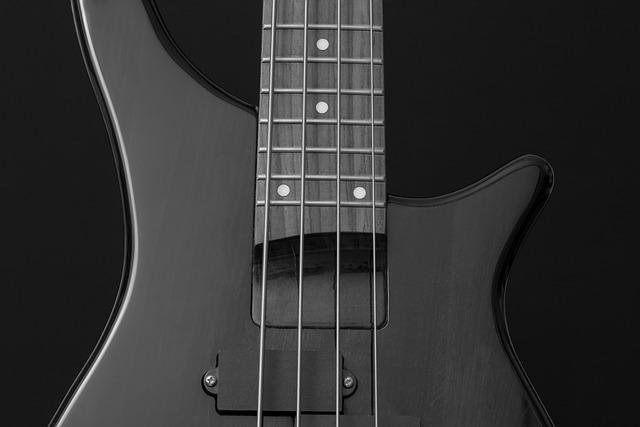Introduction to the Bass Guitar
Are you ready to learn to play bass guitar? The bass guitar, a cornerstone of contemporary music, offers a unique blend of rhythmic stability and harmonic depth. Developed in the 1930s, the bass guitar has evolved through various iterations, each contributing to its indispensable role in modern music. Initially conceived as an electric alternative to the upright bass, it has since gained prominence in genres ranging from jazz and blues to rock and funk.
There are several types of bass guitars, each tailored to specific playing styles and musical genres. The most common models include the four-string bass, five-string bass, and six-string bass. Four-string bass guitars typically serve as an entry point for beginners due to their simpler structure and ease of play. Five-string and six-string basses offer extended range, providing additional lower and higher notes, which are essential for advanced playing techniques and complex compositions.
What sets the bass guitar apart from other string instruments is its fundamental role within a band or ensemble. While guitars and keyboards often focus on melody and solos, the bass guitar primarily anchors the harmonic framework and rhythmic foundation. It accomplishes this through a combination of low-pitched notes and rhythmic patterns that align closely with the drummer’s beats, enhancing the overall groove of a piece.
The bass guitar’s versatility allows it to seamlessly integrate into various musical styles. In rock and metal, it drives the powerful, punchy rhythms; in jazz, it offers smooth, intricate lines; in funk, it lays down groovy, syncopated riffs; and in pop, it adds melodic resonance. This multifaceted nature makes learning to play bass guitar not only an enriching endeavor but also a gateway to exploring diverse musical landscapes.
By understanding the history, different types, and unique role of the bass guitar, novices can better appreciate its significance and develop a strong foundation for their musical journey. This foundational knowledge is essential for anyone seeking to learn to play bass guitar effectively and unlock its full potential within various musical contexts.
Choosing the Right Bass Guitar and Equipment
When embarking on the journey to learn to play bass guitar, selecting the right instrument and gear is a critical first step. For beginners, the decision can be daunting, but a few key considerations can guide you to a well-suited choice. Firstly, your budget plays a significant role in determining your options. Bass guitars can range from affordable starter models to high-end professional instruments. It is advisable to set a budget that balances quality and affordability.
Brand reputation is another crucial factor. Reputable brands like Fender, Ibanez, and Yamaha offer reliable options for beginners. These manufacturers are known for producing durable instruments with consistent quality. Whether you opt for an electric or acoustic bass guitar largely depends on your musical preference and the genre you intend to play. Electric bass guitars are versatile and commonly used in various music styles, while acoustic basses provide a richer, warmer sound suitable for unplugged sessions.
Size is also an essential aspect to consider, especially for younger players or those with smaller hands. Short-scale bass guitars, which have a scale length of around 30 inches, can be more comfortable and easier to play for beginners compared to standard 34-inch scale instruments. Testing different sizes in a music store can help you find the most comfortable fit.
Apart from the bass guitar itself, you will need some fundamental equipment. An amplifier is essential for electric bass guitars. Beginners might consider a combo amp, which includes both the amplifier and a speaker in one unit. This setup is convenient and often more cost-effective. Look for models with a range of volume and tone controls to help you develop your sound.
Cables are another necessity, and high-quality cables ensure a reliable signal from your bass to the amplifier. Additionally, effects pedals can enhance your playing experience by allowing you to experiment with different sounds and tones. Starting with basic effects like a tuner pedal and an overdrive pedal can provide a solid foundation.
Making informed purchases involves research and, if possible, seeking recommendations from experienced players or music store staff. By carefully selecting your bass guitar and essential equipment, you lay a strong foundation for your musical journey ahead.

Understanding Music Theory for Bassists
For those embarking on the journey to learn to play bass guitar, an understanding of music theory is instrumental in mastering the craft. At its core, music theory involves the study of notes, scales, chords, and rhythm, each of which plays a crucial role in shaping musical expression. Learning music theory is helpful for playing many musical instruments including the electric guitar. Recognizing their importance and application on the bass guitar can significantly enhance a bassist’s performance skills and versatility.
Firstly, notes are the building blocks of music. On the bass guitar, each string’s standard tuning corresponds to specific notes: E, A, D, and G. Learning the location of these notes along the fretboard allows bassists to navigate their instrument with precision. Exploring the various notes and their placements primes a bassist for grasping more complex theoretical concepts.
Scales further expand upon individual notes, providing a sequence crucial for understanding key signatures and creating melodies. The major and minor scales form the foundation of Western music. By practicing scales in different positions on the bass guitar, players not only enhance their finger strength and dexterity but also internalize essential patterns that aid in improvisation and composition.
Chords, often associated with harmony, are equally pertinent to bassists. While bass guitars typically play one note at a time, knowing the structure of chords helps in creating bass lines that complement the harmonic progression of a song. Root notes of chords serve as a starting point, but awareness of intervals and chord tones allows bassists to add depth and interest to their playing.
Rhythm, the backbone of any piece of music, demands special attention from bassists. The role of the bass guitar in maintaining and driving the groove is indispensable. Understanding time signatures, rhythmic patterns, and syncopation empowers bassists to control the tempo and energy of a performance, ensuring cohesion with other instruments.
A solid grasp of these music theory fundamentals not only aids in the technical aspect of playing but also enriches the creative and expressive capabilities of any aspiring bassist. By diligently integrating these concepts into practice routines, those eager to learn to play bass guitar can achieve a richer and more comprehensive mastery of their instrument.
Basic Techniques and Exercises for Beginners
Learning to play bass guitar starts with mastering fundamental techniques which create the foundation for advanced playing. Proper hand positioning is crucial; your left hand should form a gentle curve around the neck, allowing your fingers to press down on the strings with ease. Simultaneously, your right hand’s position varies whether you are playing fingerstyle or with a plectrum.
Fingerstyle playing, which involves using your index and middle fingers to pluck the strings, provides more control and a richer tone. Begin by positioning your thumb on the pickup or edge of the fretboard for stability, and pluck each string individually with your fingers, ensuring even volume and clarity. Conversely, using a plectrum (pick) offers a more pronounced attack and is preferred in genres like rock or punk. Hold the plectrum between your thumb and index finger, and strike the strings in a controlled manner.
Plucking the strings is another essential skill to develop. Practice alternate plucking with your index and middle fingers to achieve a smooth and rhythmic sound. This technique becomes the bedrock of your bass playing as it ensures consistency and fluidity. Start slowly and gradually increase your speed while maintaining accuracy.
To further enhance your dexterity and coordination, incorporate basic finger exercises into your practice routine. One fundamental exercise involves playing chromatic scales up and down the fretboard. Place each finger of your left hand on successive frets of a single string and pluck each note individually, descending and ascending the scale. Another effective exercise is the ‘spider walk’, in which you alternate between fingers to mimic a spider’s movement, thereby improving finger independence and stamina.
Consistent practice of these techniques and exercises not only helps you to learn to play bass guitar efficiently but also sets a solid groundwork for more advanced skills. Dedicate time to these basics, and you will observe significant improvements in your playing ability over time.
Learning to Read Bass Guitar Tabs and Sheet Music
To master the bass guitar, it is crucial to understand the two primary forms of musical notation: tablature (tabs) and standard sheet music. Each type offers unique advantages and can aid in the comprehensive development of your bass playing skills.
Tablature is a simplified form of musical notation, specifically designed for stringed instruments like the bass guitar. It uses numbers on six lines representing the strings of the guitar. The numbers indicate the fret to play. Tabs are particularly user-friendly for beginners because they visually map out finger placements on the fretboard without requiring extensive knowledge of musical theory. For instance, if you see ‘3’ on the second line from the top, it signifies you should press the third fret on the A string. Tabs are an excellent starting point for those eager to learn to play bass guitar quickly and effectively.
Meanwhile, standard sheet music offers a more traditional approach, encompassing a wider range of musical elements such as rhythm, dynamics, and articulation. It uses a five-line staff where notes are positioned to reflect their pitch and duration. Learning to read standard notation can seem daunting at first, but it is invaluable for achieving a higher level of musical versatility and expression. For example, a whole note in the open E string will be shown as a filled circle with no stem in the corresponding position on the staff.
To acquaint yourself with both notations, start by practicing simple bass lines in tablature format before transitioning to sheet music. Identify common symbols and repeatedly play short excerpts to reinforce your understanding. Numerous online resources provide exercises focusing on each reading method, ensuring you build a robust foundation. Balancing tabs with sheet music reading skills will immensely benefit your journey as you learn to play bass guitar, covering both technical and expressive facets of musicianship.
Playing Along with Songs and Backing Tracks
One of the most effective methods to learn to play bass guitar is by playing along with songs and backing tracks. This immersive approach allows you to develop timing, groove, and musical intuition. Selecting appropriate songs for practice is a crucial first step. Start with simple tracks that feature clear bass lines, such as classic rock or blues songs. As you grow more comfortable, you can gradually increase the difficulty level, tackling more complex pieces and genres.
Playing in time with the music is fundamental to becoming a proficient bass guitarist. It’s essential to lock in with the drummer, as the bass and drums form the rhythmic foundation of most musical ensembles. Use a metronome or drum machine during practice to develop a strong sense of timing. As you progress, try to play along with songs, paying close attention to the rhythm and groove of the bass lines. This practice will help you internalize the feel of various musical styles.
Incrementally increasing the difficulty level of the songs you play is another key strategy. Start by mastering the basic patterns and scales before moving on to more sophisticated techniques like slap bass, fingerstyle, or walking bass lines. This gradual approach ensures that your development is steady and comprehensive.
Several online resources and mobile apps can aid your learning process. Apps like Ultimate Guitar, Yousician, and BassGuru offer extensive libraries of song tutorials and backing tracks. Websites such as YouTube and Songsterr also provide valuable instructional content, including step-by-step bass tutorials and play-along videos. These tools can significantly enhance your practice sessions by providing structured guidance and diverse backing tracks to play along with.
Incorporating these strategies into your practice routine will not only make learning to play bass guitar more enjoyable but also more effective. By consistently practicing with songs and backing tracks, you’ll develop the skills and confidence needed to master the art of playing bass guitar.
Developing Your Own Playing Style
As you continue your journey to learn to play bass guitar, one of the most critical aspects is developing a unique playing style. This process involves combining advanced techniques with personal exploration to create a sound that sets you apart from other bassists. By mastering techniques like slap and pop, harmonics, and muting, you will significantly expand your musical vocabulary.
The slap and pop technique, popularized by funk bassists, involves striking the strings with your thumb (slap) and pulling them with your fingers (pop). This method produces a percussive, rhythmic sound that can add a dynamic layer to your playing. To integrate this into your style, practice the slap and pop on different strings and frets, gradually increasing speed and complexity.
Harmonics offer another avenue for variation. Natural harmonics are produced by lightly touching the string at specific points, usually over the 12th, 7th, and 5th frets, without pressing down. This technique creates bell-like tones that can add texture and richness to your bass lines. Experiment with harmonics in different contexts—whether within a solo or as part of a groove—to see how they resonate with your musical expression.
Muting techniques, using either your right or left hand, are essential for controlling resonance and maintaining a clean sound. For instance, palm muting with your right hand can create a warmer, more controlled tone, useful in genres like jazz or blues. Similarly, using your left-hand fingers to mute strings can help in creating a ‘staccato’ effect, giving your bass lines a more rhythmic, articulated character.
Improvisation and bass line writing are also critical to developing a unique style. When improvising, use scales and arpeggios as your foundational tools, but don’t be afraid to go off-script. This freedom allows you to discover new patterns and phrases that can become signature elements of your style. Writing your own bass lines gives you full control over the structure and dynamics of the music, helping to blend your technical skills with creative flair.
Finally, immerse yourself in various genres and listen to different bassists. From jazz legends like Jaco Pastorius to rock icons like John Entwistle, each has something unique to offer. Remember that inspiration often comes from unexpected places. The more diverse your listening habits, the richer and more versatile your playing style will become.

Tips for Continued Progress and Overcoming Challenges
When striving to learn to play bass guitar, it is essential to maintain motivation and set realistic practice goals to ensure continued progress. One effective strategy is to create a structured practice schedule that includes both dedicated practice time and small, achievable milestones. This not only provides a clear roadmap but also instills a sense of accomplishment as each goal is reached.
A common challenge faced by many bassists is hitting plateaus, where progress seems to stall. To overcome these periods, it is helpful to diversify your practice routine. Incorporate a mix of technical exercises, new songs, and improvisation. By continuously challenging yourself with varied material, you can stimulate learning and maintain enthusiasm.
Physical strain is another obstacle that bass players may encounter. Proper technique and posture are crucial to avoid injuries. Ensure you are using correct hand positions and taking frequent breaks during practice to prevent fatigue. Stretching exercises specifically designed for musicians can also alleviate tension and promote durability.
To keep practice sessions engaging, consider incorporating multimedia resources such as instructional videos or backing tracks. These tools can provide new perspectives and add excitement to your routine. Joining a band or collaborating with other musicians can further enhance your experience. Playing with others not only builds camaraderie but also exposes you to new styles and techniques, accelerating your growth as a bassist.
Taking lessons from a professional teacher can also provide significant benefits. An experienced instructor can offer personalized guidance, correct bad habits, and introduce advanced concepts in a structured manner. Additionally, a teacher can serve as a source of motivation and accountability, helping you stay on track with your learning goals.
Tracking your progress is fundamental to staying motivated. Keep a practice journal to document your achievements, challenges, and areas for improvement. Reflecting on your journey allows you to appreciate how far you’ve come and identify patterns that may require adjustment.
By incorporating these strategies, you can navigate the journey to learn to play bass guitar at an advanced level if you so desire. Remember to stay with it for continued success and enjoyment.

